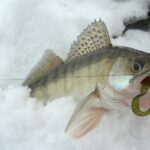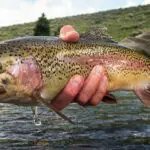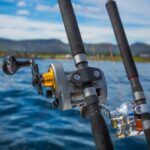If you are looking for a fishing experience that challenges you physically and mentally while trying to locate, attract, hook and land skittish fish, rock fishing might be for you. While you can technically rock fish from any rocky outcropping, hardcore rock fishing is most commonly associated with Australia and New Zealand.
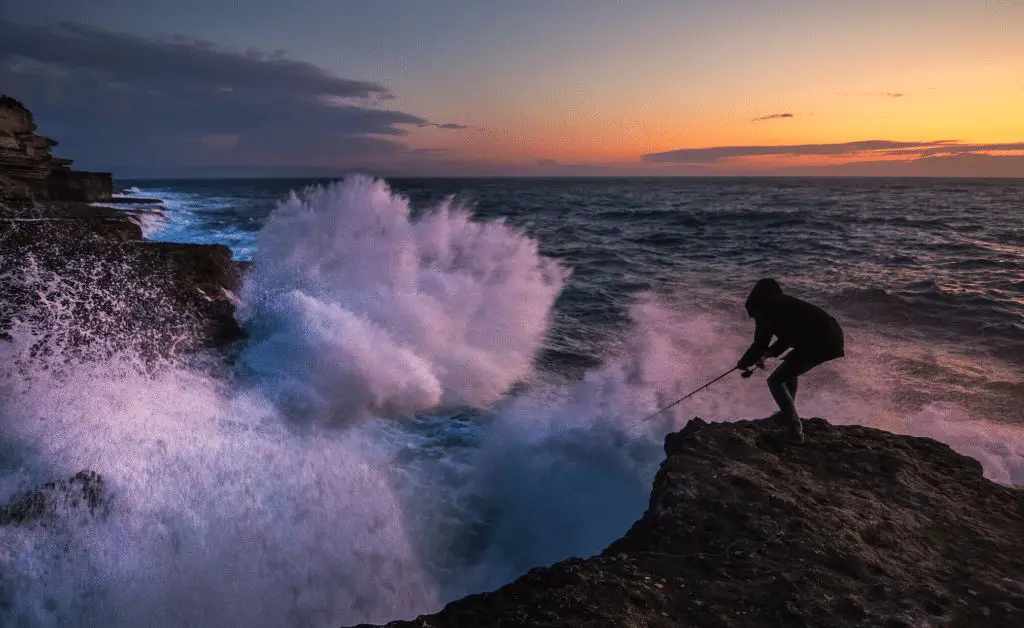
Here is all you need to know about rock fishing, including what you need to start and how to stay safe.
What Is Rock Fishing?
Rock fishing is fishing in an ocean, river, or lake, off a rock outcropping, alongside a rocky shoreline, or off cliffs. There are two reasons for targeting outcroppings. First, rocky shoals, outcroppings, piles, and cliffs often provide shelter and protection for baitfish. Second, the same rocks also provide protection and a place to surprise prey for predator fish.
Most often done with a rod and reel, with live bait or lures, the allure is potentially landing big fish that live in and around rocks while tackling the challenges of rugged surf, jagged rocks, and very slippery surfaces. Often, anglers use a dropper loop rig or umbrella rig with a bait or lure trailer. In some areas, handlining is also a popular form of the sport, and some even fly fish off rock outcroppings to catch rockfish.
Species You Can Catch While Rock Fishing
Any fish that lives in or near rock outcroppings or rock structures are fair game. Most anglers will target species that are popular in the area they are fishing, so they stand a better chance of catching more fish.
For example, someone rock fishing off the rocks in Cape Ann, Massachusetts, might target striped bass off the rocky shorelines. On the west coast of the USA, rockfish fishing is popular. Anglers will brave dangerous surf and unpredictable tides to catch rockfish, which can present a challenge because of fishing pressure.
Here is a list of the most common fish targeted by rock fishermen for both fresh and saltwater.
- Drum: Drum usually in warmer saltwater at medium depths.
- Grouper: Grouper live in saltwater and like fairly deep drop-offs off rock structures.
- Bocaccio: This is a Pacific Coast Rockfish.
- Copper rockfish: Catch these in the Eastern Pacific ocean.
- Starry rockfish: Stary rockfish are located up and down the Pacific coast.
- Vermilion rockfish: These fish live around Baja, California, and off the Alaskan coast.
- Striped bass, smallmouth, rock, and largemouth bass: These can be caught in freshwater and saltwater (stripers) and often like rocks to look for prey.
Where To Go Rock Fishing
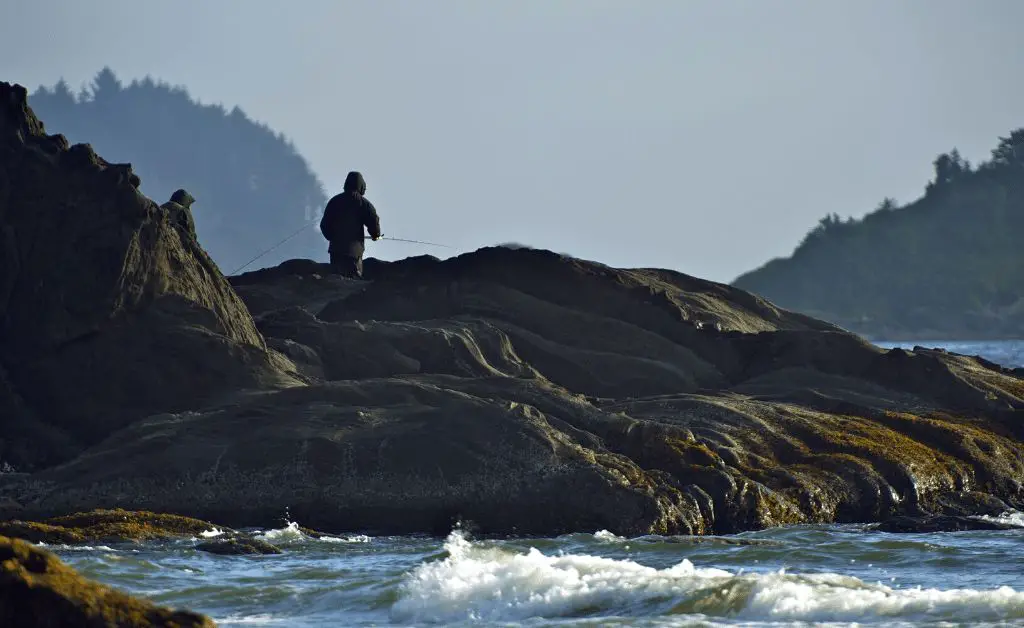
There are four keys to increasing the likelihood you will catch a fish when rock fishing:
- Rocky environments for baitfish to hide and swim around
- Access to deeper water for predator fish
- Rocks to hide, rest, and wait for prey under and around
- Proximity to vegetation like kelp beds and patches of aquatic grass or vegetation
These three provide the three things all fish want: A place to flee if necessary, a place to rest or wait for prey, and food sources that attract prey.
To locate the best place for rock fishing near you or where you are visiting, internet maps and fishing locators are great sources, as is visiting a local bait shop and asking for advice on where to go.
Additionally, tools like Google Earth and Google Maps provide surprisingly detailed images of outcroppings, shallow water, channels to deep water, and areas that fall off to deep water quickly.
Another source is you. Grab a map of the area and hoof it to where you think might provide good rock fishing. Notice if others are fishing there. Scout the area from every angle possible and take note of the contour, slopes, rock structure, water channels, etc. Use this information to help you set up and fish in the spot, most likely, in your opinion, to yield fish.
Rock Fishing Gear and Supplies
The gear you need for rock fishing is simple: Rod, reel, line, rigging, artificial lures, or live bait. Here is what to look for when choosing your fishing kit.
Rod and Reel
You want your rod to be long enough to allow you to cast a long distance. Your action should be medium, and you want to use a spinning rod and reel. Your reel should be a spinning reel for saltwater and capable of holding at least 200 yards of heavy test line.
Line
Your fishing line needs to be as heavy as your reel can handle and still give you a minimum of 200 yards. a 20-pound monofilament fishing line works best. You can also use braid (if it is legal to use braid where you are fishing,) which will let you get a lot more line at a heavier test threshold. If you opt for a braid, you want to use a heavy leader off your main line.
Rig
The simplest rock fishing rigs are weight and hook. A tri-swivel will let you attach your weight (let the current in the area determine how heavy) and the hook. The best advice for hook size is to ask around and get a sense of the size of fish people normally catch.
Plan on using larger hooks (2 to 4/0,) but the locals can give you a better idea of the preferred hook size. You can use 1/0 and 2/0 size hooks with soft baits.
Baits and Lures
If you opt to use lures, choose larger lures with treble hooks. The hook size on the lure depends on the target fish. In almost every case, your hooks should be at least 4/0 or higher. For color, choose something flashy that presents a contrast. Silver and blue work well almost everywhere, but you should ask other anglers what colors they use as well.
For baits, again, go with what the locals use. It is common for a local area to have a preference based on what the fish are used to eating. As a failsafe, stick with bait fish or shrimp, as both are almost a universal choice for gamefish.
Supplies
Supplies are up to you, and what you will likely encounter should dictate what you bring. At a minimum, you should have the following:
- Sunscreen
- Hat
- Rain gear
- Slip-resistant shoes
- Nonalcoholic beverages (rock fishing is not the time to tap into a brew because of the danger of slipping and falling)
- Snacks
- Rod holder (in case you set up next to an outcropping)
- Sweatshirt or long sleeve shirt
- Lightweight shorts or pants (or both)
If the fish are not biting, you might spend a lot of time waiting, so bringing some other form of entertainment (radio, crossword puzzles, etc.) is a good idea as well.
How To Go Rock Fishing
Once you have your gear and supplies ready to go, it is time to get fishing. Here is some general rock fishing advice.
Arrive Early
You can convince a fish to eat at any time of the day or night, but early morning is the best. The fish are active, you can see where you are walking or climbing, and the fish have not retreated to hide from the sun.
Casting
Spinning reels are easy to cast but require a little practice. The best technique is to secure your line with the index finger of the arm you will cast with and pull the ball back, letting the weight of your lure or weight keep the line taught. Bring the rod back and cast, releasing the line from your finger much like you would release a baseball you were throwing.
Practice if you have never used a spinning reel. Spinning reels are easy to use once you get the hang of them, but they can be moderately challenging for beginners.
Reeling
Let your bait or lure sit in the water once you cast it. If you are free lining, let the bait go where it wants. If you are jigging or using a lure, twitch your line occasionally while slowly reeling it enough to get whatever action the lure has going.
Staying Safe While Rock Fishing
Rock fishing is safe, but only if you are careful and use common sense. Here is some advice.
Check the Weather
Weather can come up in a hurry. Check it before you go, and use a weather app on your smartphone if you have one. If you see weather approaching on the radar, track how fast it is moving, as that can give you an idea of when it will hit your area. If you hear thunder, pack it up and get to safety.
Scout Ahead
Visit the area you will be fishing in beforehand and identify areas that will present navigation challenges. You also want to note the tide lines so if you are fishing at low or lower tide, you can plan on when high tide comes in and not get stranded.
Use a High Vantage Point
Fish from the highest vantage point possible. The highest point gives you a bird’s eye view of the fishing area and what you are facing.
Wear Appropriate Gear
Wear clothing that will not get bogged down if it gets wet. Bring rain gear. Wear non-slip shoes.
Don’t Fish Alone
Whenever possible, do not fish alone. A partner can help you if you get into trouble. They can also alert someone if you need help.
Frequently Asked Questions
The following are some frequently asked questions about rock fishing.
Is night fishing always dangerous?
If you take the proper precautions, no. That said, fishing at night is more dangerous than day fishing because your vision is restricted. Even taking a hook out of a fish is challenging if you do not have the right lighting.
What’s the best time of year to go rock fishing?
That depends entirely on what you are fishing for and is also why it is best to talk to a local fisherman and ask them for advice before you get your line wet.
Is rock fishing the same as surf fishing?
Rock fishing is not the same as surf fishing as it is typically defined. Surf fishing is usually done on the beach by shore anglers, while rock fishing is done on rock outcroppings. Surf fishing is stationary while you move a bit with rock fishing.
Final Thoughts
Rock fishing is fun if you have the right gear and choose the right places to place your lure or bait. Keeping safe is something you should keep in mind always, as rock fishing can be dangerous. You can catch some monsters just a short distance offshore if you achieve all that.
- Do You Need An Indicator For Nymph Fishing? - November 16, 2023
- Fishing Safety Tips For Families - September 25, 2023
- What Is The Best Time To Night Fish At A Lake? - September 18, 2023


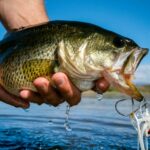

![Kayak Fishing for Beginners [10 Tips for a Successful Trip] fishing kayak moored on a beach](https://irvinelake.net/wp-content/uploads/2022/12/kayak-fishing-for-beginners-150x150.png)

